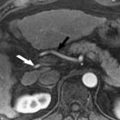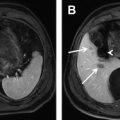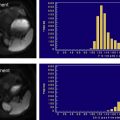Clinical hepatobiliary magnetic resonance (MR) imaging continues to evolve at a fast rate. However, three basic requirements must still be satisfied if novel high-field MR imaging techniques are to be included in the hepatobiliary imaging routine: improvement of parenchymal contrast, suppression of respiratory motion artifact, and anatomic coverage of the entire hepatobiliary system. This article outlines the various arenas involved in MR imaging of the hepatobiliary system at 3 Tesla (T) compared with 1.5 T by (1) highlighting magnetic field–dependent MR contrast phenomena that contribute to the overall appearance of high-field hepatobiliary imaging; (2) summarizing the biodistributions of different gadolinium chelates used as MR contrast agents and their effectiveness regarding the static magnetic field; (3) showing the implementation of advanced imaging techniques such as three-dimensional acquisition schemes and parallel acceleration techniques used in T1-, T2-, and diffusion-weighted hepatobiliary imaging; and (4) addressing artifact mechanisms exacerbated by, or originating from, increase of the static magnetic field.
Magnetic resonance (MR) imaging has proved to be a comprehensive modality for assessment of morphologic and functional characteristics of the hepatobiliary system in clinical scenarios of focal and diffuse liver disease. Concurrent technical improvements, such as amplification of the static magnetic field, development of powerful gradient systems, and multichannel phased-array body coils, as well as implementation of advanced imaging sequence designs using respiratory-triggered and three-dimensional data acquisition schemes, realize high-quality examinations of the hepatobiliary system with T1-, T2-, and also diffusion-weighted pulse sequences.
This article highlights the basic concepts of MR imaging of the hepatobiliary system using high static magnetic fields and its imaging effects in noncontrast, as well as contrast-enhanced, imaging.
Gains in contrast from an increase of the magnetic field
The strengthening of the static magnetic field of clinical imaging systems affects MR phenomena through various contrast mechanisms; however, doubling the magnetic field does not necessarily double the parenchymal contrast on MR imaging series on high-field MR imagers because of counteracting MR contrast phenomena. General estimations of signal/noise ratios (SNR) for spin-echo–based (SNR SE ) and gradient-echo–based (SNR GE ) sequence designs are approximated according to
S N R S E α B 0 V ( N P E N P A N A V B W ) ( 1 − e − T R T 2 ) e − T E T 2
and
S N R G E α B 0 V ( N P E N P A N A V B W ) sin ( ) ( 1 − e − T R T 1 ) ( 1 − e − T R T 1 cos ( ) ) e − T E T 2 *
Stay updated, free articles. Join our Telegram channel

Full access? Get Clinical Tree






